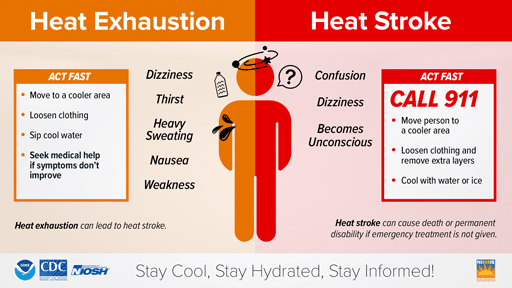Whether you believe in global warming or not, this is one of the hottest summers on record for the planet Earth. June 2023 was the hottest June on record going back 174 years according to the National Oceanic and Atmospheric Administration (NOAA).
First, a few stats:
• The month of July was the first time since 1974 Phoenix had 18 days in a row of 110-degree or higher temps. Meteorologists predicted Phoenix would break that 49-year-old record and hit a nineteenth day of extreme high temps.
• The forecast for that day called for a high of 115 degrees Fahrenheit. The temperatures are “very extreme,” said Matt Salerno, a meteorologist with the National Weather Service in Phoenix, in a report in the New York Times. “We’re talking 10 degrees above where they normally are.”
• Another heat record the city of Phoenix set on Monday evening, July 17, was for eight consecutive days in which the overnight temperature never dipped below 90 degrees.
• According to Heat.gov, close to 100 million people across the United States were under active National Weather Service extreme heat advisories, watches and warnings.
• Every June for the last 47 years has been hotter than the twentieth century average for the month.
• This June was the hottest month ever recorded for the world’s oceans.
Elsewhere in the world, things aren’t much better. The Persian Gulf International Airport in Iran reported a heat index of 152°F (66.7 C) on July 16 at 12:30 p.m. A remote town in China set a record temp of 126 F (52.2 C) on Sunday, July 16, that country’s state media reported.
And, according to the European Environmental Agency, “Europe is warming faster than the global average. The mean annual temperature over European land areas in the last decade was 2.04 to 2.10 C warmer than during the pre-industrial period. The year 2020 was the warmest year in Europe since the instrumental records began according to all datasets used, with the range of anomaly between 2.53 C and 2.71 C above the pre-industrial levels. Particularly high warming has been observed over eastern Europe, Scandinavia and at the eastern part of the Iberian Peninsula.”
More than 61,000 people died due to summer heat waves across Europe in 2022 a recently published study in Nature Medicine stated.
Why write about high temps and possible global warming in a magazine about the business of aircraft maintenance? Anyone who has worked in this industry knows exactly why. These high temps are especially concerning for people who work outside or in hangars that are not climate-controlled, as well as for people with any type of chronic illness such as cardiovascular or respiratory disease. This means you or the people who work for you.
Officials recommend learning the signs of heat exhaustion, heatstroke and other heat-related illnesses, staying hydrated and taking time to adjust and acclimate to the environment when temperatures rise. Signs of heat exhaustion include sweating, fatigue, dizziness and headache. A person experiencing heat exhaustion might experience nausea or lightheadedness, muscle cramping, increased fatigue and accelerated heart rate. See image.

Know when to seek medical attention. This would be necessary when a person begins to show signs of heat-related illness. First, it is recommended to move the person to the coolest place possible, give them water or an electrolyte drink and keep skin moist with a wet washcloth. Remove unnecessary clothing such as shoes, socks and jackets. Then, observe and monitor their symptoms which will hopefully improve within 30 minutes, experts say. If they don’t get better or start having worse symptoms, seek medical help. Heatstroke looks like rapid breathing and rapid heart rate, confusion and loss of consciousness/passing out. This is a serious, life-threatening condition that requires immediate medical assistance.
It’s important to stay hydrated with water or electrolytes (like sports drinks). If you don’t want to consume the sugar in sports drinks, make your own electrolytes at home. An easy electrolyte recipe would be lemon and pink salt in water. If you want to get a bit fancier, add potassium chloride (a quick source is Lite Salt) and magnesium (in the form of magnesium citrate) as well as a sweetener, like stevia. There are recipes on the internet.
For those of you working in this heat — take care of yourselves. For those of you supervising a workforce in this heat, please be proactive about taking care of your people.
Good luck and stay cool!
